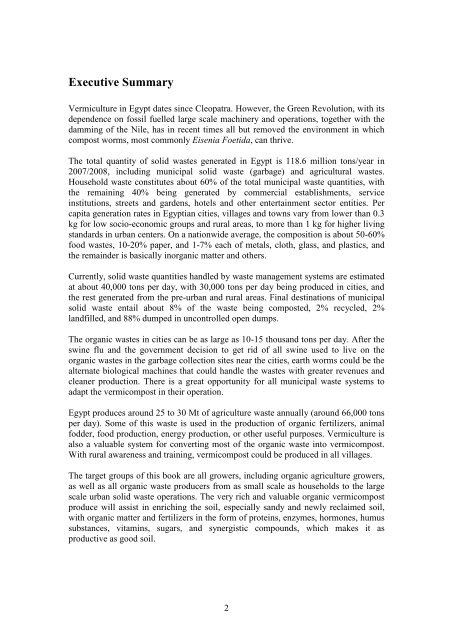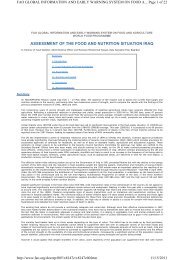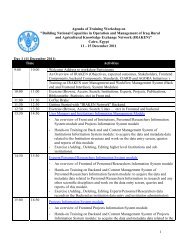Vermiculture in Egypt: - FAO - Regional Office for the Near East and
Vermiculture in Egypt: - FAO - Regional Office for the Near East and
Vermiculture in Egypt: - FAO - Regional Office for the Near East and
You also want an ePaper? Increase the reach of your titles
YUMPU automatically turns print PDFs into web optimized ePapers that Google loves.
Executive Summary<br />
<strong>Vermiculture</strong> <strong>in</strong> <strong>Egypt</strong> dates s<strong>in</strong>ce Cleopatra. However, <strong>the</strong> Green Revolution, with its<br />
dependence on fossil fuelled large scale mach<strong>in</strong>ery <strong>and</strong> operations, toge<strong>the</strong>r with <strong>the</strong><br />
damm<strong>in</strong>g of <strong>the</strong> Nile, has <strong>in</strong> recent times all but removed <strong>the</strong> environment <strong>in</strong> which<br />
compost worms, most commonly Eisenia Foetida, can thrive.<br />
The total quantity of solid wastes generated <strong>in</strong> <strong>Egypt</strong> is 118.6 million tons/year <strong>in</strong><br />
2007/2008, <strong>in</strong>clud<strong>in</strong>g municipal solid waste (garbage) <strong>and</strong> agricultural wastes.<br />
Household waste constitutes about 60% of <strong>the</strong> total municipal waste quantities, with<br />
<strong>the</strong> rema<strong>in</strong><strong>in</strong>g 40% be<strong>in</strong>g generated by commercial establishments, service<br />
<strong>in</strong>stitutions, streets <strong>and</strong> gardens, hotels <strong>and</strong> o<strong>the</strong>r enterta<strong>in</strong>ment sector entities. Per<br />
capita generation rates <strong>in</strong> <strong>Egypt</strong>ian cities, villages <strong>and</strong> towns vary from lower than 0.3<br />
kg <strong>for</strong> low socio-economic groups <strong>and</strong> rural areas, to more than 1 kg <strong>for</strong> higher liv<strong>in</strong>g<br />
st<strong>and</strong>ards <strong>in</strong> urban centers. On a nationwide average, <strong>the</strong> composition is about 50-60%<br />
food wastes, 10-20% paper, <strong>and</strong> 1-7% each of metals, cloth, glass, <strong>and</strong> plastics, <strong>and</strong><br />
<strong>the</strong> rema<strong>in</strong>der is basically <strong>in</strong>organic matter <strong>and</strong> o<strong>the</strong>rs.<br />
Currently, solid waste quantities h<strong>and</strong>led by waste management systems are estimated<br />
at about 40,000 tons per day, with 30,000 tons per day be<strong>in</strong>g produced <strong>in</strong> cities, <strong>and</strong><br />
<strong>the</strong> rest generated from <strong>the</strong> pre-urban <strong>and</strong> rural areas. F<strong>in</strong>al dest<strong>in</strong>ations of municipal<br />
solid waste entail about 8% of <strong>the</strong> waste be<strong>in</strong>g composted, 2% recycled, 2%<br />
l<strong>and</strong>filled, <strong>and</strong> 88% dumped <strong>in</strong> uncontrolled open dumps.<br />
The organic wastes <strong>in</strong> cities can be as large as 10-15 thous<strong>and</strong> tons per day. After <strong>the</strong><br />
sw<strong>in</strong>e flu <strong>and</strong> <strong>the</strong> government decision to get rid of all sw<strong>in</strong>e used to live on <strong>the</strong><br />
organic wastes <strong>in</strong> <strong>the</strong> garbage collection sites near <strong>the</strong> cities, earth worms could be <strong>the</strong><br />
alternate biological mach<strong>in</strong>es that could h<strong>and</strong>le <strong>the</strong> wastes with greater revenues <strong>and</strong><br />
cleaner production. There is a great opportunity <strong>for</strong> all municipal waste systems to<br />
adapt <strong>the</strong> vermicompost <strong>in</strong> <strong>the</strong>ir operation.<br />
<strong>Egypt</strong> produces around 25 to 30 Mt of agriculture waste annually (around 66,000 tons<br />
per day). Some of this waste is used <strong>in</strong> <strong>the</strong> production of organic fertilizers, animal<br />
fodder, food production, energy production, or o<strong>the</strong>r useful purposes. <strong>Vermiculture</strong> is<br />
also a valuable system <strong>for</strong> convert<strong>in</strong>g most of <strong>the</strong> organic waste <strong>in</strong>to vermicompost.<br />
With rural awareness <strong>and</strong> tra<strong>in</strong><strong>in</strong>g, vermicompost could be produced <strong>in</strong> all villages.<br />
The target groups of this book are all growers, <strong>in</strong>clud<strong>in</strong>g organic agriculture growers,<br />
as well as all organic waste producers from as small scale as households to <strong>the</strong> large<br />
scale urban solid waste operations. The very rich <strong>and</strong> valuable organic vermicompost<br />
produce will assist <strong>in</strong> enrich<strong>in</strong>g <strong>the</strong> soil, especially s<strong>and</strong>y <strong>and</strong> newly reclaimed soil,<br />
with organic matter <strong>and</strong> fertilizers <strong>in</strong> <strong>the</strong> <strong>for</strong>m of prote<strong>in</strong>s, enzymes, hormones, humus<br />
substances, vitam<strong>in</strong>s, sugars, <strong>and</strong> synergistic compounds, which makes it as<br />
productive as good soil.<br />
2





